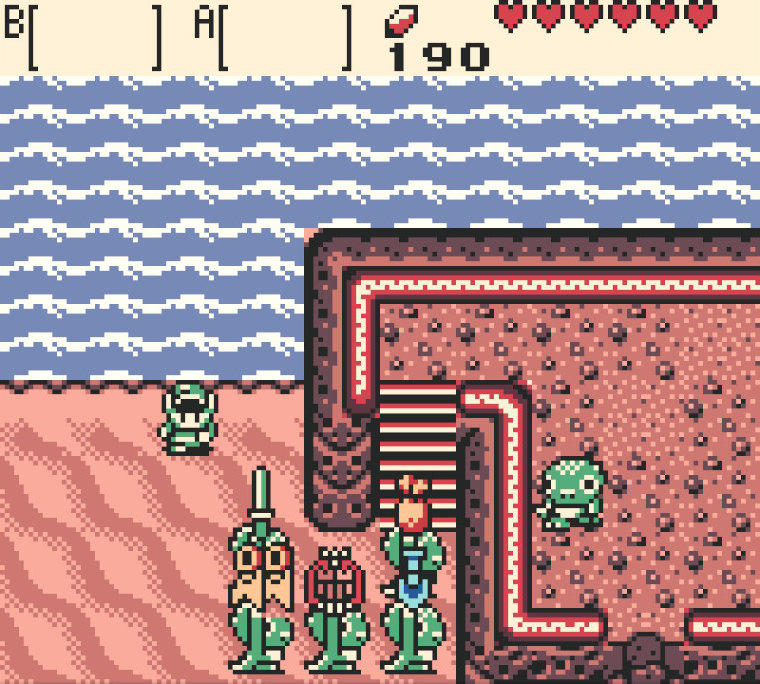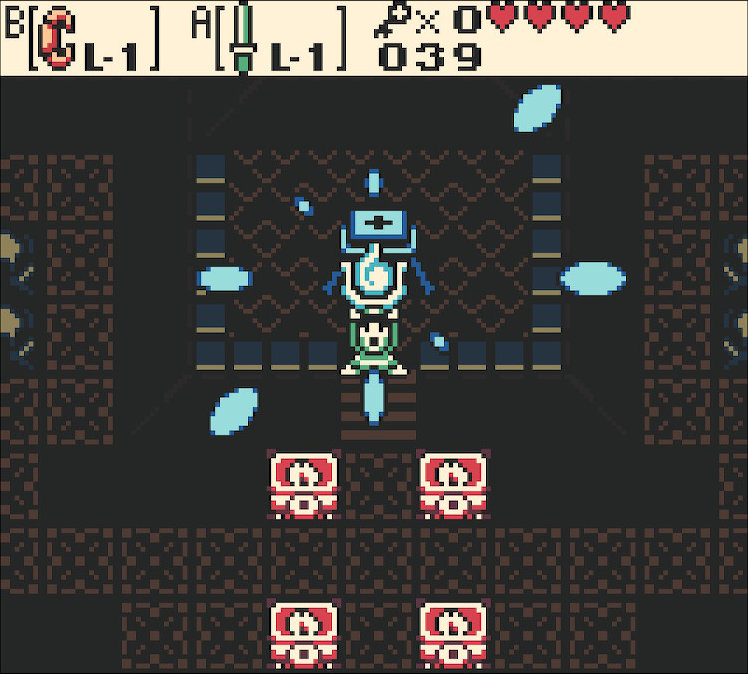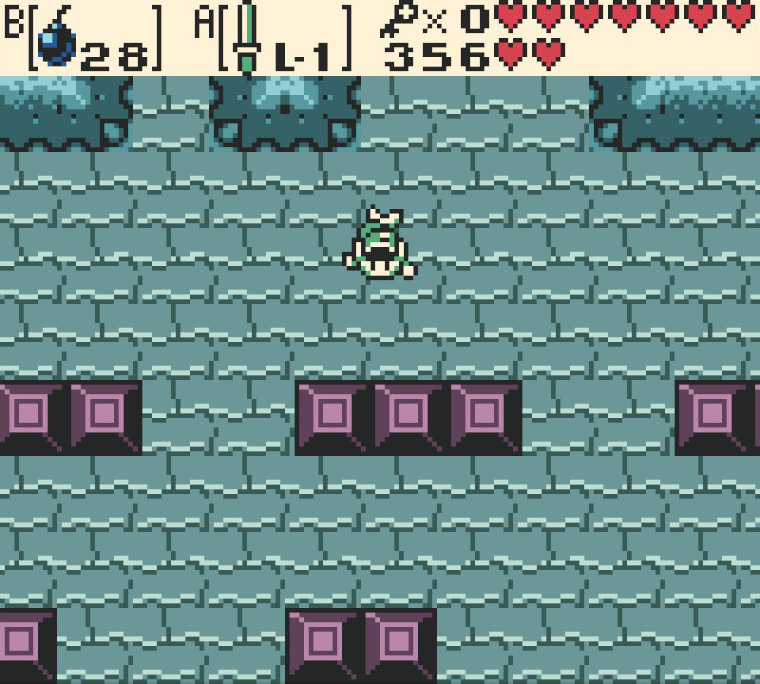The Legend of Zelda: Oracle of Ages and its counterpart, The Legend of Zelda: Oracle of Seasons, were released during a time of transition for both the Zelda series and video games as a whole. In 2001, Oracle of Ages was one of the last Game Boy Color games before the release of the Game Boy Advance, and Zelda fans were preparing for the release of the Nintendo GameCube a few months later. The Nintendo 64 had given developers a few years of 3D game development experience, but a lot of ideas were still experimental, and 3D gaming was still new. Many popular game series had not yet made the jump to 3D or had struggled to do so, but Zelda was arguably the series with the greatest success in making the jump to 3D.
Oracle of Ages and Oracle of Seasons were the first Zelda games to take the series back to its 2D top-down roots after the success of Ocarina of Time and Majora’s Mask, and the developers brought with them what they had learned from 3D game design. I am certain this felt amazing in 2001. A 2D game with 3D game design elements on a handheld must have felt like holding Ocarina of Time in your palm. But some of these choices have aged very poorly. We have a stronger understanding of what works and what doesn’t in 2D and 3D game design, and some parts of Oracle of Ages just don’t work.
At least partially inspired by the success of Pokémon, the new Zelda games were a pair that could connect to each other. Unlike Pokémon, the Oracle games are not the same game with minor changes. Instead, they are completely different games that can be played alone or as a pair. You can play the games in either order, and the second game will have some changes if you enter a password provided after the credits of the first game. Playing both also unlocks a secret ending and secret items. It’s an interesting idea that could be more elegantly implemented today but ultimately has very little effect on the quality of either game individually.
Oracle of Ages will feel familiar to fans of Ocarina of Time and A Link to the Past. It’s a game about time travel, but where Ocarina of Time lets you switch time only from a single point, the Temple of Time, Oracle of Ages eventually lets you swap between two time periods from anywhere on the map. It feels more like swapping between the Light World and Dark World in A Link to the Past but with more freedom and a more logical sense of why change happens.
The two overworlds are the past and the present of Labrynna, a land outside of Hyrule to which Link has been sent. Because the changes in the world are based on simple time travel, the changes you make in the past affect the present in a way that makes sense and rarely feels arbitrary. This is the biggest success of the game. The time travel mechanics are implemented better here than in any other Zelda game with a similar two-world setup.
You are traveling through time to rescue Nayru, the titular Oracle of Ages, from Veran, a sorceress whose true intentions become clear as the game’s story progresses. The story is simple and mostly serves as a reason to justify your traveling around the world collecting new items. Unfortunately, the story ends on a cliffhanger if you only play Oracle of Ages and do not follow it up with Oracle of Seasons. The secret true ending of the game is only accessible if you play both, and it’s the only way to get the full conclusion of what is going on in either game. This is mostly a gimmick, and I do not really like it. The true ending is mostly a boss fight with a bit of extra dialogue. It might have seemed like a novel storytelling method in 2001, but it feels more like a ploy to sell you twice as many games in 2023.
The moment-to-moment gameplay is excellent. It is directly lifted from Link’s Awakening. There are new enemies and new characters, but the overall graphic style is a duplicate of the previous handheld adventure. The combat controls are also the same, and that means Oracle of Ages suffers from the same lack-of-buttons problem as its predecessor. You should expect to be opening the menu frequently to swap your equipped items because you only have two buttons to work with. The sword and shield do not have dedicated buttons, and lifting a rock or pot does not have a dedicated button. You will be opening the menu to equip the right item to perform almost every task. I expected this to bother me a lot after playing the Link’s Awakening remake and other modern Zelda games, but it was less of a nuisance than I expected. I formed a rhythm and generally got in and out of the menu quickly.
The world of Labrynna is populated by new and returning characters that I think are very memorable. Tingle makes his first 2D appearance on the outskirts of town; you meet and team up with Ricky, a friendly kangaroo; Ralph is a fun wannabe hero who’s always on your heels; and you have frequent run-ins with Maple, a witch’s apprentice, and compete to steal each other’s dropped belongings. The characters and environments are brought to life with a solid soundtrack. It’s not the best soundtrack in the Zelda series, but some of the tracks are quite memorable.
The central time travel mechanic, controls, graphics, story, and characters all lay the foundations for an excellent Zelda game, but Oracle of Ages stumbles in the execution of the main quest.
The world of Labrynna is well-designed, but the activities in it are not. The beginning of the game is very straightforward, but on your way to the second dungeon, you encounter the first big obstacle. You play hide-and-seek with some fairies in the forest, but the fairies have scrambled the forest layout. You wander around the scrambled maze looking for the exact path to find the fairies. There’s no Old Man in a cave to tell you the right solution. It’s just trial and error until you figure it out.
To reach the third dungeon, you complete an interesting quest involving building a raft, but then you immediately crash your raft and have all of your items stolen by the Tokay people, the locals of an island you wash up on. You then have to hunt down the Tokay and and convince them to give your items back. This includes winning a minigame with a perfect score.


This continues for the entire game with the lead-up to the sixth dungeon arguably being the worst. It requires winning several minigames in both time periods. It feels like the developers did not know what tasks to have you complete, so they just started throwing in random minigames to block your progress. Some players might enjoy these parts of the game. I do not. I find all of it to be incredibly tedious and mostly not fun.
When you get through the slog of outdoor activities, you are rewarded with some of the most confusing and frustrating dungeons in any Zelda game. It’s often said that Oracle of Seasons is focused on combat and Oracle of Ages is focused on puzzles. There’s truth in this, but I think the puzzles in Oracle of Seasons are more fun to solve.
Oracle of Ages has two common types of puzzles. The first are obstacles that, like the overworld minigames, feel like they were just put in to make the game take longer. You will frequently push around little square blocks with different colored sides in just the right way to make the correct color be on top. It’s a neat puzzle theme for one “color dungeon,” but they repeat it for even the most mundane switch puzzles throughout the whole game.
The more infuriating obstacle is the rotating doors that are placed at almost every crossroads in the game. It’s the most infuriating version of a revolving door ever designed. Instead of giving you easy access to explore four different rooms or just putting a lock on one of the doors, they instead make you walk around in circles repeatedly to get anywhere. It’s never fun and it’s not even really a “puzzle”; it’s just a waste of time.
The other type of puzzles in Oracle of Ages would be excellent… if this were a 3D game. There are multiple dungeons that require strong spatial awareness that you cannot get playing on a tiny square screen with everything separated. The Water Temple in Ocarina of Time can be confusing, but when you change the water level, you see it happen and understand that you have performed an action that affected the entire dungeon. You may have even been to a room previously, and you “just know” that your water level adjustment has given you access to a new area because you saw it flooded before. There is a similar dungeon in Oracle of Ages with water-level mechanics, but it doesn’t work. You change the water level from a central room, but you just hear a “whoosh” sound effect and are expected to understand what that means when you can only see one square at a time.


In a similar vein, there’s a time travel dungeon that is poorly executed. Instead of the seamless time travel mechanic from the overworld, you have to leave the dungeon entirely, change the time period, and then re-enter the dungeon. There’s no good way to know when the right time to leave the dungeon and change the time period is; I’m not even sure how many times you are supposed to change the time period. This leads to repeated backtracking through the entire dungeon.
Fortunately, the dungeons do have some highlights. Oracle of Ages introduces some great new items that include the Seed Shooter, a projectile launcher with five different types of ammo that cause different effects, and the Switch Hook, a new take on the classic Hookshot that lets you trade places with the object you are grappling toward. As brand-new items, they never see their full potential realized, and I think it’s a shame that we have not seen the Switch Hook, in particular, in any other Zelda games.
The Cane of Somaria, an item that creates blocks in front of Link, also returns from A Link to the Past. In its second (and, so far, last) appearance, the developers were able to use the block-summoning abilities to create more interesting puzzles. The Cane of Somaria feels like a prototype for an ability that would not feel out of place in a more modern game like Breath of the Wild.
The bosses are another highlight of each dungeon. There are a couple of frustrating moments, but overall the bosses and mini-bosses make excellent use of your items, and defeating them can feel like solving a puzzle. I especially like Smog, a Cane of Somaria puzzle boss fight, and Plasmarine, a Switch Hook focused boss fight.
The Legend of Zelda: Oracle of Ages has a lot of charm. I love the world and the characters, and the items make exploring Labrynna a fun experience. There were enough excellent qualities to keep me playing despite repeatedly encountering frustrating main quest scenarios. In the end, Oracle of Ages feels too ambitious for its hardware. The rudimentary password system cannot provide a satisfying two-game experience, the dungeons feel like they were designed for 3D, and the activities between dungeons feel like the developers ran out of time and needed to impede progress with minigames and tedious roadblocks disguised as puzzles. I remember enjoying the game more when I was younger, and I have no doubt that it was appreciated as a very ambitious game upon release. But Oracle of Ages has… aged poorly.


